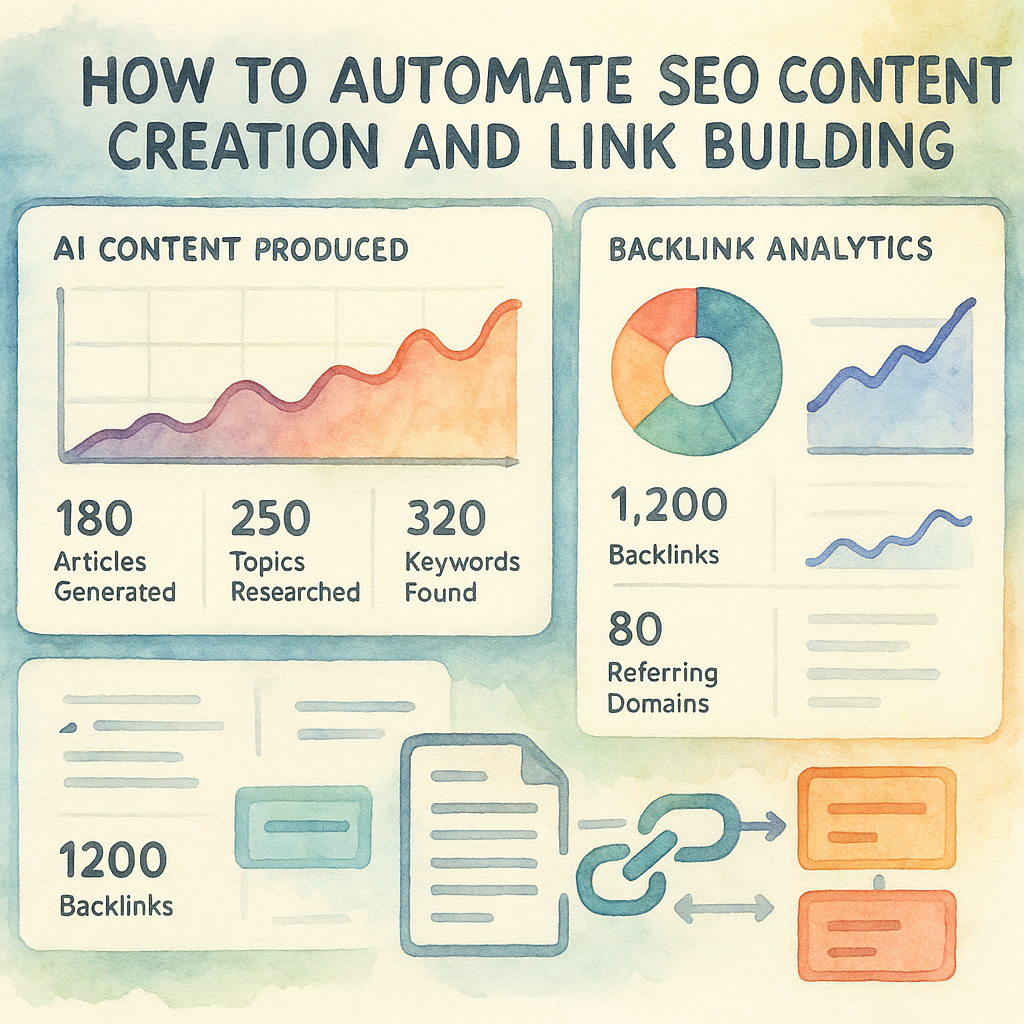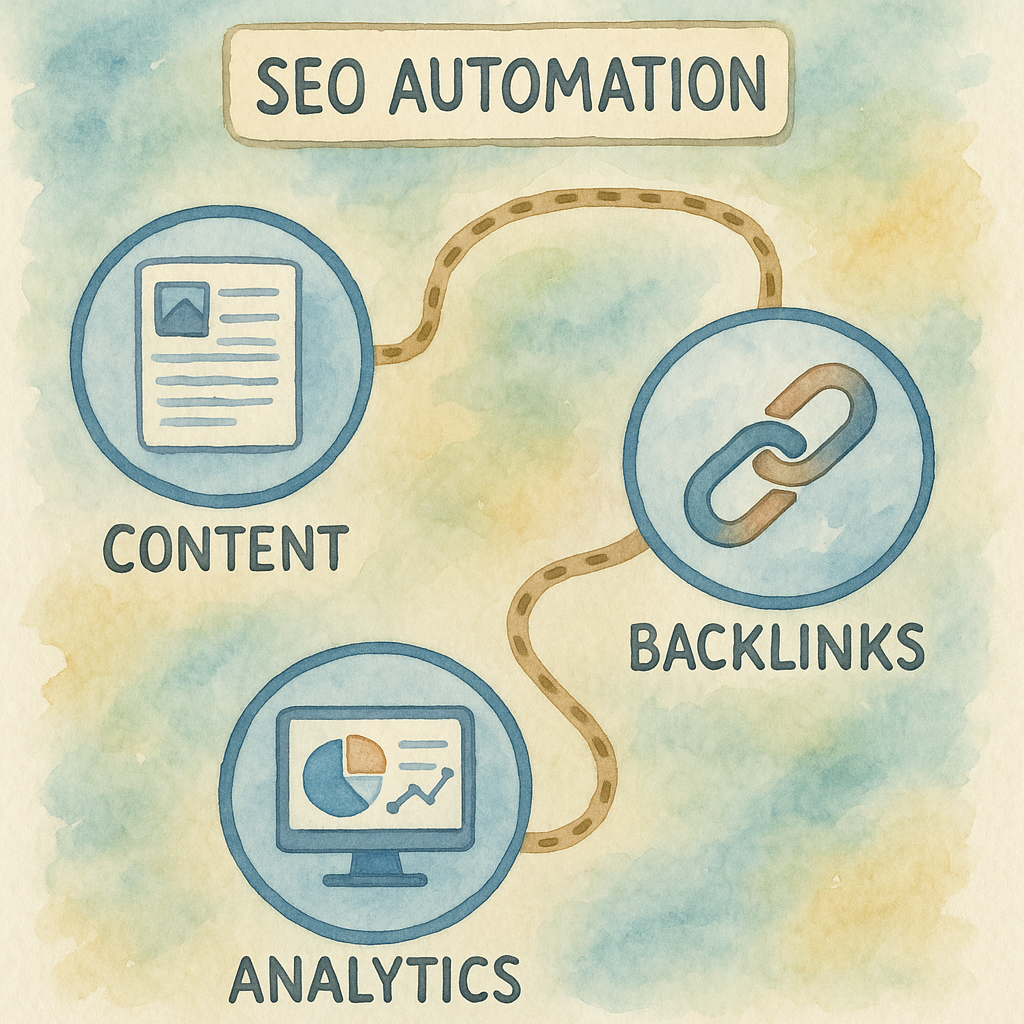Automation is reshaping SEO faster than ever.
But how can you effectively automate SEO content creation and link building without losing quality?
In this detailed guide, we'll cover every step, tool, and strategy you need to streamline your SEO efforts and scale results.
Some are leveraging AI to research and generate SEO-optimized content faster than manual teams.
Some are integrating automated backlink networks to boost domain authority without endless outreach.
Some are using data-driven workflows to align content with user intent and evolving AI search algorithms.
Some are blending human expertise with AI automation for quality and scale.
Some are shifting focus from old tactics to actionable strategies tuned for the 2025 SEO landscape.
Let's dive right in.
What Is Automated SEO Content Creation and Link Building?
Automated SEO content creation means using AI tools and software to research, write, optimize, and publish content targeting specific keywords with minimal manual effort. It turns time-consuming content tasks into workflows that run on autopilot.
Automated link building refers to leveraging platforms and AI algorithms that identify, secure, or create backlinks for your website without manual outreach fatigue. High-quality backlinks remain a crucial ranking factor in 2025.
Together, these automation processes help digital marketing teams scale online authority and organic traffic effectively, while saving hours on repetitive tasks.
Why does it matter? SEO fundamentals remain solid, but SEO execution has evolved dramatically due to AI and search engine updates.
“Google still receives 5 trillion searches a year, so SEO is far from dead. It’s simply evolved,” shares a leading SEO expert in a recent industry analysis. (Verified with sources as of 2025-09-24)
Why Should You Automate SEO Content Creation and Link Building?
Manual SEO content creation and link building are slow, inconsistent, and expensive. Here are the key reasons automation matters today:
- Speed: AI-powered workflows shrink content research and production from hours to minutes, enabling rapid scale.
- Consistency: Automation ensures a steady stream of optimized articles that align with your SEO strategy.
- Cost-Efficiency: Save on hiring multiple writers and outreach specialists while maintaining quality.
- Adaptability: Quickly pivot content to meet new search engine algorithms, user intent, and AI search trends.
- Link Quality: Automated systems build targeted backlinks from relevant authoritative sources, vital for rankings.
According to an SEO strategist in a 2025 SEO forecast, combining “high-quality content with an automated backlink network is the key to ranking success, especially with generative AI shaking up traditional search.”
How to Automate SEO Content Creation: Step-by-Step
Let’s explore a detailed workflow to automate your content creation efficiently.
1. Start with Targeted Research Using AI Tools
Effective automation begins with understanding your niche and audience. Instead of relying solely on generic AI prompts, blend tools that collect and summarize competitor content and trending topics.
- Use AI transcription and summarization tools to scrape competitor video transcripts or blog content, rapidly extracting key insights.
- Analyze popular queries and content gaps with automated keyword research software.
- Map searcher intent to tailor your content—are they beginners, experts, or comparison shoppers?
This targeted research forms the foundation of your content strategy and helps AI generate original, useful articles.
2. Outline Content Automatically with Custom AI Models
Create detailed article outlines using custom-trained AI that understands your brand tone and SEO goals.
Instead of asking AI to write entire scripts or articles upfront (which can lead to errors or repetition), produce section-by-section outlines that guide the writing.
This makes your automation controlled and focused, reducing post-editing work.
3. Generate and Optimize Content with AI Assistance
Use AI text generators to expand your outlines into full articles. Ensure SEO elements like keyword density, natural language, and subtopic coverage while maintaining a reader-first mindset.
For best results, continuously tweak the AI prompts to avoid generic or “hallucinated” content. Insider tip: ask AI to write content from the perspective of a real expert to build authority.
Embed rich media like images or videos alongside text to enhance engagement and SEO performance.
4. Automate On-Page SEO and Metadata Integration
Leverage tools that auto-generate SEO metadata including meta titles, descriptions, schema markup, and alt tags. This boosts search engine understanding and click-through rates with minimal manual effort.
Some platforms can also schedule content publishing based on SEO priority and track initial performance metrics automatically.
5. Incorporate a Human Touch for Quality Assurance
Despite AI’s power, human review remains valuable. Use editors to validate content quality, fact-check, and ensure brand voice consistency before publishing.
This hybrid approach achieves scale without sacrificing credibility, aligning well with Google’s emphasis on expertise, authority, and trustworthiness (E-A-T).
How to Automate Link Building Efficiently
Link building is essential but traditionally time-intensive. Automating this process requires strategic use of AI and platforms designed for quality backlink acquisition.
1. Use Automated Link Prospecting Tools
AI-powered tools can scan the web, analyze competitor backlink profiles, and identify high-value link prospects tailored to your niche.
They efficiently generate curated lists of blogs, websites, directories, and media outlets that are relevant and authoritative.
2. Streamline Outreach with Automated Guest Posting Platforms
Automate the outreach email campaigns through platforms that personalize guest post pitches at scale while managing follow-ups.
They optimize response rates and reduce manual labor, allowing you to secure quality backlinks consistently.
3. Leverage AI to Generate Content for Backlinks
Create targeted articles, infographics, or resources automatically for guest posting or resource pages. Ensuring relevance and informative value maximizes the chance of link acceptance.
4. Monitor and Reclaim Broken or Lost Links Automatically
Advanced SEO tools alert you when backlinks go dead or are lost, prompting automated reclamation emails or link replacements.
This proactive approach preserves your link equity without constant manual tracking.
5. Integrate with AI-Powered Backlink Networks
Some solutions offer networks of vetted sites for reliable backlinks generated and indexed automatically. Joining these networks can strengthen your domain authority faster.
Rely on platforms like Rebelgrowth’s AI-powered backlink network that are designed to automate without risking spammy link profiles.
What Are the Best AI Tools to Automate SEO Content and Link Building?
Choosing the right tools is critical for successful automation. Here are some categories and examples widely used in 2025:
- Content Research & Summarization: AI transcription and summarization tools that extract key insights from competitor videos and blogs.
- AI Writing Assistants: Custom-trained GPT-like models to outline and generate SEO-optimized text at scale.
- Metadata & Schema Generators: Software that automates SEO metadata and structured data integration for faster optimization.
- Automated Link Prospecting: Tools that crawl and generate backlink opportunities based on niche relevance.
- Outreach Automation Platforms: Email marketing and CRM integrations that personalize and send link building pitches efficiently.
- Backlink Monitoring: Solutions that track link health, lost links, and opportunities for reclamation.
For real-world insights on workflow and toolset usage, check out this step-by-step AI content creation and automation workflow that has helped creators cut production time by hours.
How Does Automation Fit into the New AI-Driven SEO Landscape?
SEO in 2025 has evolved due to the flood of AI-generated content and the rise of generative engine optimization (GEO). Simply churning out generic content no longer ranks.
Google and other AI search engines prefer:
- Content demonstrating real expertise and trustworthiness.
- Clear, concise answers that align with user intent.
- Consistent brand presence across authoritative platforms.
Automation helps you meet these demands by ensuring content quality and relevance, while scaling production and backlink acquisition intelligently.
This dual approach tackles both traditional search rankings and AI overviews that aggregate responses on collective knowledge.
Brands that use an automated content engine combined with a robust backlink network unlock a first-mover advantage in these emerging search formats (source: detailed SEO forecasts and AI search analyses).
How Can I Balance Automation with Human Expertise?
Automation speeds up processes but doesn’t replace human insight entirely. Here’s how to blend both:
- Strategic Oversight: Have SEO specialists analyze AI-driven research and tune strategies based on market shifts and search trends.
- Quality Review: Editors curate AI-generated content to ensure brand tone, fact accuracy, and readability.
- Relationship Building: Maintain personal touch in link outreach for stronger partnerships beyond automated emails.
- Performance Monitoring: Use analytics to continuously refine automated workflows and focus human resources on high-impact areas.
This human-AI partnership delivers the best of both speed and expertise, amplifying SEO success sustainably.
What Common Mistakes Should I Avoid When Automating SEO?
Automation requires smart execution. Avoid these pitfalls:
- Over-reliance on Generic AI: Don’t use generic prompts or tools blindly. Guide AI with data and clear SEO goals.
- Neglecting User Intent: Focus on what searchers want, not just keywords.
- Ignoring Link Quality: Avoid automated backlinks from irrelevant or low-authority domains—reputation matters.
- Skipping Manual Review: Always vet AI content and outreach communications before going live.
- Failing to Update Strategies: SEO is dynamic. Automate only with tools tuned to current best practices and algorithm changes.
These mistakes can reduce automation ROI and damage your SEO standing long-term.
Are you optimizing your SEO processes for 2025 and beyond? Leveraging automation smartly will determine who thrives in the competitive AI-driven search landscape.

How Do I Get Started with Automation in SEO?
Follow this actionable checklist to kick off your SEO automation journey:
- Identify repetitive and time-consuming tasks in content creation and link building.
- Research and trial AI tools optimized for those tasks.
- Set up pilot workflows for automated research, content outlines, and backlink prospecting.
- Train your team on AI prompt engineering and review processes.
- Monitor output quality, site rankings, and backlink health regularly.
- Gradually scale automation while maintaining human oversight.
- Continuously optimize workflows with emerging technologies and shifts in SEO best practices.
To learn more on how to build your first AI-powered content planner or backlink automation, check out our detailed guides like How to Automate SEO Content Creation and How to Build Backlinks Automatically.
Common Questions about Automating SEO Content Creation and Link Building
Is automated content always low quality?
No, when guided correctly and combined with human editing, AI-generated content can meet high editorial and SEO standards better than rushed manual articles.
Will automating link building get my site penalized?
Not if you use reputable automated backlink networks and tools focused on quality, relevance, and avoid spammy tactics. Google values backlinks from authoritative and relevant sources.
How long before I see results from automation?
With a well-structured automation system, initial improvements in content volume and backlink profile may show within weeks, but SEO rankings usually stabilize over 3 to 6 months.
Can small businesses benefit from SEO automation?
Absolutely. Automation levels the playing field by saving time and budget, allowing small and mid-sized companies to compete with larger firms in content and link building.
What’s Your Next Step?
Tell us in the comments: How will you apply automation to your SEO content and link building? For personalized advice, explore our content marketing strategies to learn how a systematic approach complements automation for best results.
